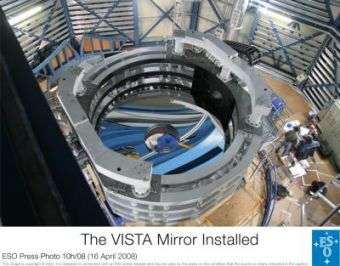Paranal receives new mirror

A 4.1-metre diameter primary mirror, a vital part of the world's newest and fastest survey telescope, VISTA (the Visible and Infrared Survey Telescope for Astronomy) has been delivered to its new mountaintop home at Cerro Paranal, Chile. The mirror will now be coupled with a small camera for initial testing prior to installing the main camera in June. Full scientific operations are due to start early next year. VISTA will form part of ESO's Very Large Telescope facility.
The mirror arrived over the Easter weekend at the Paranal Observatory where the telescope is being assembled at an altitude of 2518m, in Chile's Atacama Desert.
VISTA Project Manager Alistair McPherson from STFC's UK Astronomy Technology Centre (UK ATC) accompanied the mirror on its journey to Chile: "This is a major milestone for the VISTA project. The precious mirror was loaded on to a plane in a special cradle that used tennis balls to cushion it from impact for its arduous journey across three continents. "
"The mirror had a difficult four-day journey, by air and by road. It arrived in perfect condition and now that it has been coated, we will install the mirror in the telescope with a small test camera for about four weeks testing. We plan to install the main camera in June," said the Project Scientist on VISTA, Will Sutherland of Queen Mary, University of London, UK.
The VISTA 4.1-metre diameter primary mirror is the most strongly curved large mirror ever polished to such a precise and exacting surface accuracy - deviations from a perfect surface of less than 1/3000th of the thickness of a human hair. On arrival at Cerro Paranal it was safely craned into the telescope dome where it was washed and coated with a thin layer of protected silver in the facility's coating plant. Silver is the best metal for the purpose since it reflects over 98% of near-infrared light, better than the more commonly used aluminium. To date, the reflectivity produced by the silver coating- a relatively new venture - is well above that specified and exceeds all other telescopes.
VISTA will survey large areas of the southern sky at near infrared wavelengths (2 to 4 times the wavelength of visible light) to study objects that are not seen easily in optical light either because they are too cool (such as brown dwarfs), or are surrounded by interstellar dust which infrared light penetrates much better than optical, or whose optical light is redshifted into the near infrared by the expansion of the Universe. Amongst other things VISTA's surveys will help our understanding of the nature and distribution and origin of known types of stars and galaxies, map the 3-D structure of our galaxy, and help determine the relation between the 3-D structure of the universe and the mysterious 'dark energy' and dark matter'. Samples of objects will be followed up in detail with further observations by other telescopes and instruments such as the nearby Very Large Telescope.
"The delivery of the last component of VISTA is a significant milestone and we are delighted with the progress made since the mirror arrived. Now astronomers can really look forward to being able to perform unparalleled observing of our Southern skies," said Richard Wade, President of the ESO Council and STFC Chief Operating Officer.
Source: ESO



















